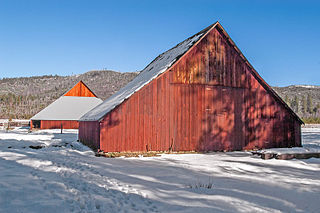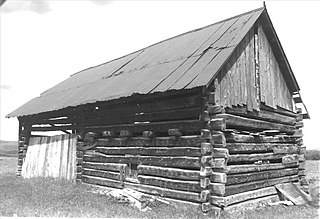
Avent Cabin, in the Great Smoky Mountains National Park near Elkmont, Tennessee, United States, is an early Appalachian mountain cabin that was used as a summer studio and retreat by noted artist Mayna Treanor Avent (1865–1959). It is listed on the National Register of Historic Places.

The Old Faithful Historic District in Yellowstone National Park comprises the built-up portion of the Upper Geyser Basin surrounding the Old Faithful Inn and Old Faithful Geyser. It includes the Old Faithful Inn, designed by Robert Reamer and is itself a National Historic Landmark, the upper and lower Hamilton's Stores, the Old Faithful Lodge, designed by Gilbert Stanley Underwood, the Old Faithful Snow Lodge, and a variety of supporting buildings. The Old Faithful Historic District itself lies on the 140-mile Grand Loop Road Historic District.

The Whitcomb Mansion is a historic house at 51 Harvard Street in Worcester, Massachusetts. It is a high Victorian mansion that was built in 1879 as the home of George H. Whitcomb, one of the city's leading businessmen and philanthropists. It is also one of the few surviving houses designed by noted Worcester architect Stephen Earle.

The Vardy Community School was a Presbyterian mission school established in the Vardy community of Hancock County, Tennessee, United States, in the late-19th and early-20th centuries. At the time of its founding, the school was the only institution providing primary education to children of the multi-racial Melungeon communities, who lived in the remote mountainous areas along the Tennessee-Virginia border.

Graham-Brush Log House is a historic home located in the Town of Pine Plains, Dutchess County, New York. It was built in about 1776 and is a two-room log structure with a wood frame lean-to on its rear elevation. It measures roughly 39 feet long and 18 feet wide. It is one and one half stories with a gable roof; the lean-to addition is one story. The Brush house was acquired in 1997-1998 by the local historical society, the Little Nine Partners Historical Society. In 1998 it was damaged by an arson fire.

The Tioga Pass Entrance Station is the primary entrance for travelers entering Yosemite National Park from the east on the Tioga Pass Road. Open only during the summer months, the entrance station consists of two historical buildings, a ranger station and a comfort station, built in 1931 and 1934 respectively. Both are rustic stone structures with peeled log roof structures, and are examples of the National Park Service rustic style employed at the time by the National Park Service. Two log gate structures that had been removed since the site's original construction were rebuilt in 1999; the stone piers that supported them remain. The use of stone at Tioga Pass set a precedent for the extensive employment of stone construction in other park buildings in the Yosemite high country. Civilian Conservation Corps workers assisted in the entrance station's construction.

The McCauley and Meyer Barns in Yosemite National Park are the last barns in the park that retain their original characteristics as structures built by homesteaders. The McCauley barn and the two Meyer barns represent different construction techniques and styles of design.

The Botten Cabin, also known as the Wilder Patrol Cabin, was built in 1929 in the Elwha River valley for Henry H. Botten. The hunting cabin is located in the backcountry of what in 1938 became Olympic National Park in the U.S. state of Washington. The remote cabin was built by local settler Grant Humes for Botten, who used it until his death in 1953. Botten's widow continued to apply for special use permits into the 1960s. More recently, the National Park Service has used the cabin as a backcountry patrol cabin. The cabin is one of only two former private hunting camps left in Olympic National Park.

Union Congregational Church and Parsonage, built in 1886, is a historic church located at 110 Bennett Street in Buffalo, Wyoming. It was the first church built in Buffalo, and one of the first two churches established in the northern part of the Wyoming Territory.

Lonesomehurst Cabin is a log cabin style recreational residence on the west side of the South Fork Arm of Hebgen Lake near West Yellowstone, in Gallatin County, Montana. Hebgen Lake is on the Madison River. There are three buildings on the site: a wood-frame cabin constructed circa 1919, a log boathouse built in 1958, and a wood frame outhouse built about 1930. The cabin is at the south end of the site, which is 8 miles (13 km) west of West Yellowstone and the entrance to Yellowstone National Park.

Mars Hill is a historic church building and cemetery located near Ottumwa, Iowa, United States. Barbara Clark donated the property to the Baptist Church and the church building was built between 1850 and 1857. The rectangular structure is composed of dovetail notched hewn logs, and it is capped with a gable roof. The front door is a copy of the original. It is thought that its name comes from its location, but that cannot be substantiated. Local lore has it that the church building served as a stop on the Underground Railroad. The property was listed on the National Register of Historic Places in 1974.

Saint Henry's Evangelical Lutheran Church and Cemetery is a church located on M-38 in Laird Township near Nisula. It was listed on the National Register of Historic Places in 2013.
Elliott House, also known as Chester County Log Cabin, is a historic home located near Richburg, Chester County, South Carolina. It was built about 1770, and is a two-story, late 18th to early 19th century log dwelling. The house features a tall shed-roofed porch across the front, a steeply pitched gable roof, an end chimney, stone piers, and dovetailed log joints. The interior floors and ceilings are original heart pine.

The Elk Lake Guard Station is a United States Forest Service cabin located in the Deschutes National Forest southwest of Bend, Oregon. The guard station was built in 1929 on the north shore of Elk Lake. It was used as a home base for Forest Service personnel who protected forest resources, maintained facilities, and aided summer visitors in the Cascade Lakes area of Central Oregon. After decades of use, the cabin was renovated in the late 1990s. Today, the historic guard station serves as a Forest Service visitor information center along the Cascade Lakes Scenic Byway. The Elk Lake Guard Station is listed on the National Register of Historic Places.
The Larsson–Noak Historic District encompasses a collection of buildings constructed by Swedish immigrants to northern Maine between about 1888 and 1930. The district is focused on a cluster of four buildings on Station Road, northeast of the center of New Sweden, Maine. Notable among these is the c. 1888 Larsson-Ostlund House, which is the only known two-story log house built using Swedish construction techniques in the state. Across the street is the c. 1900 Noak Blacksmith Shop, a virtually unaltered building housing original equipment. The district was listed on the National Register of Historic Places in 1989.

The Woods Landing Dance Hall was built in 1927 by Hokum Lestum for Mayme and Clarence Lewellen near Woods Landing, Wyoming. The site had previously been the Woods Landing Saloon, established by Colonel Samuel Wood in 1883. After the death of Clarence in 1936, Mayme married Hokum and they operated the dance hall and cafe until the death of Hokum in 1970. Mayme continued to operate it until the 1980s.
The George Becker House, near Los Ojos, New Mexico, was built in 1918–19. It was listed on the National Register of Historic Places in 1985.
The Ramon Jaramillo House and Barn, on Encenada Rd. in Encenada, New Mexico, was listed on the National Register of Historic Places in 1986.

The Gilbert Martinez Barn near Los Ojos, New Mexico was built around 1875. It was listed on the National Register of Historic Places in 1985.
The Casados House, in Rio Arriba County, New Mexico near Los Ojos, New Mexico, was built in 1885. It was listed on the National Register of Historic Places in 1985.















